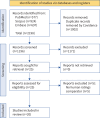Artificial intelligence in bronchoscopy: a systematic review
- PMID: 40436614
- PMCID: PMC12117383
- DOI: 10.1183/16000617.0274-2024
Artificial intelligence in bronchoscopy: a systematic review
Abstract
Background: Artificial intelligence (AI) systems have been implemented to improve the diagnostic yield and operators' skills within endoscopy. Similar AI systems are now emerging in bronchoscopy. Our objective was to identify and describe AI systems in bronchoscopy.
Methods: A systematic review was performed using MEDLINE, Embase and Scopus databases, focusing on two terms: bronchoscopy and AI. All studies had to evaluate their AI against human ratings. The methodological quality of each study was assessed using the Medical Education Research Study Quality Instrument (MERSQI).
Results: 1196 studies were identified, with 20 passing the eligibility criteria. The studies could be divided into three categories: nine studies in airway anatomy and navigation, seven studies in computer-aided detection and classification of nodules in endobronchial ultrasound, and four studies in rapid on-site evaluation. 16 were assessment studies, with 12 showing equal performance and four showing superior performance of AI compared with human ratings. Four studies within airway anatomy implemented their AI, all favouring AI guidance to no AI guidance. The methodological quality of the studies was moderate (mean MERSQI 12.9 points, out of a maximum 18 points).
Interpretation: 20 studies developed AI systems, with only four examining the implementation of their AI. The four studies were all within airway navigation and favoured AI to no AI in a simulated setting. Future implementation studies are warranted to test for the clinical effect of AI systems within bronchoscopy.
Copyright ©The authors 2025.
Conflict of interest statement
Conflict of interest: The authors have no conflicts of interest to disclose.
Figures
Similar articles
-
Comparative diagnostic performance and safety of radial endobronchial ultrasound versus its combination with electromagnetic or virtual bronchoscopic navigation for peripheral pulmonary lesions: a retrospective study.Ther Adv Respir Dis. 2025 Jan-Dec;19:17534666251355130. doi: 10.1177/17534666251355130. Epub 2025 Jul 13. Ther Adv Respir Dis. 2025. PMID: 40652340 Free PMC article.
-
Health professionals' experience of teamwork education in acute hospital settings: a systematic review of qualitative literature.JBI Database System Rev Implement Rep. 2016 Apr;14(4):96-137. doi: 10.11124/JBISRIR-2016-1843. JBI Database System Rev Implement Rep. 2016. PMID: 27532314
-
Falls prevention interventions for community-dwelling older adults: systematic review and meta-analysis of benefits, harms, and patient values and preferences.Syst Rev. 2024 Nov 26;13(1):289. doi: 10.1186/s13643-024-02681-3. Syst Rev. 2024. PMID: 39593159 Free PMC article.
-
Artificial intelligence for detecting keratoconus.Cochrane Database Syst Rev. 2023 Nov 15;11(11):CD014911. doi: 10.1002/14651858.CD014911.pub2. Cochrane Database Syst Rev. 2023. PMID: 37965960 Free PMC article.
-
The measurement of collaboration within healthcare settings: a systematic review of measurement properties of instruments.JBI Database System Rev Implement Rep. 2016 Apr;14(4):138-97. doi: 10.11124/JBISRIR-2016-2159. JBI Database System Rev Implement Rep. 2016. PMID: 27532315
References
Publication types
MeSH terms
LinkOut - more resources
Full Text Sources
Medical

